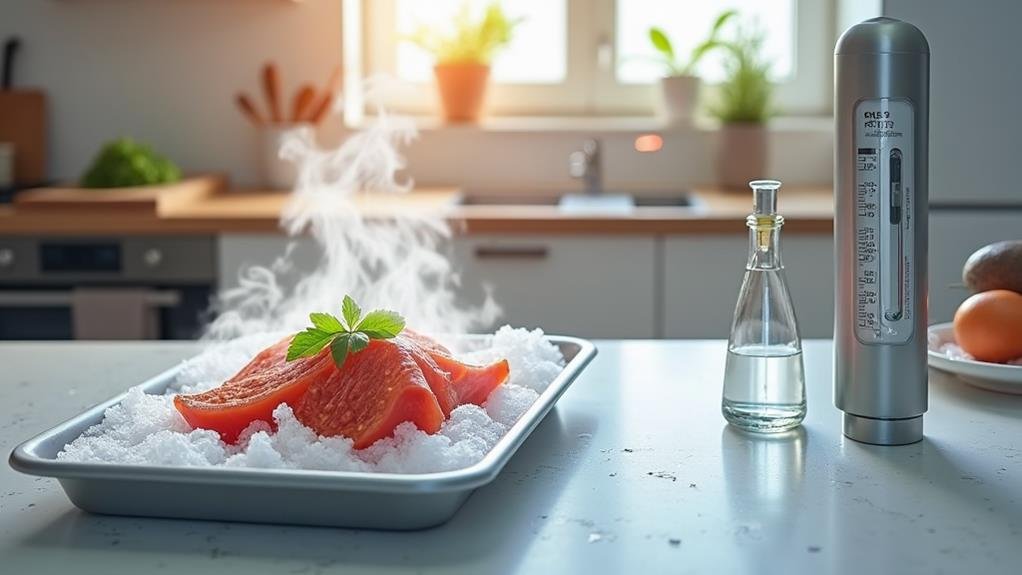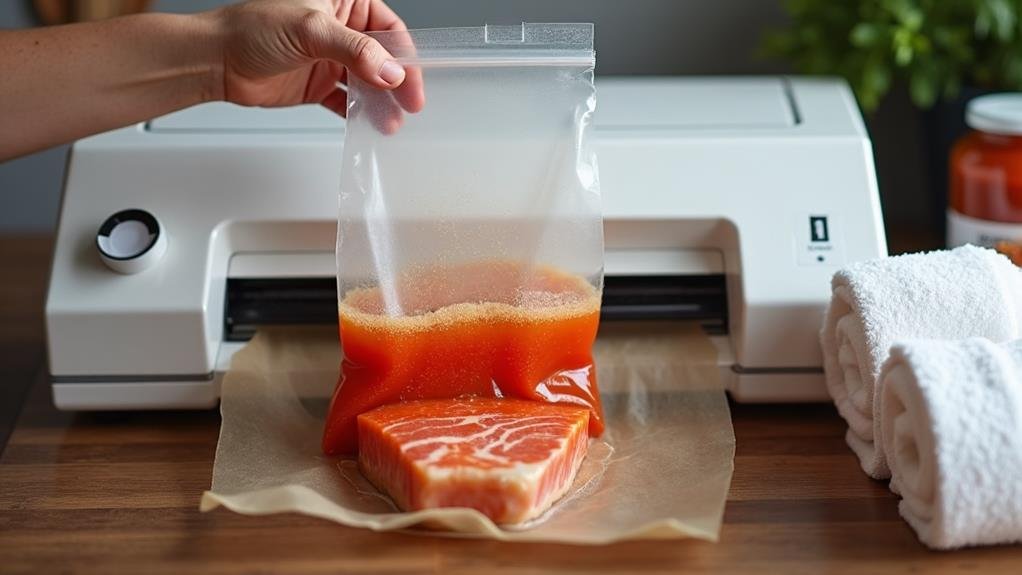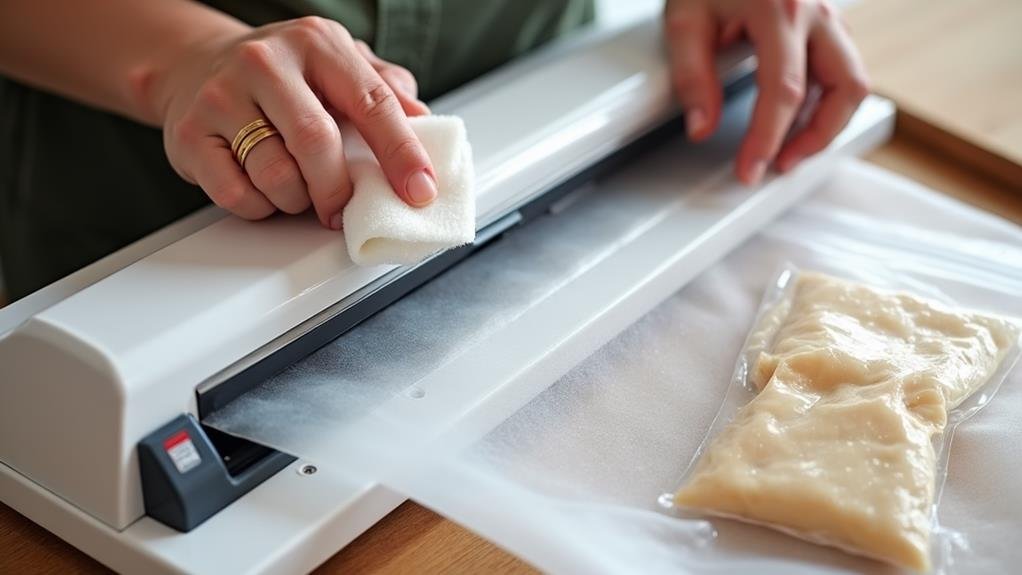When I first started using my vacuum sealer, I made the mistake of sealing hot soup directly after cooking it, only to find myself dealing with a messy explosion of liquid and a compromised seal. This experience taught me a valuable lesson: cooling hot food to below 41°F is pivotal before vacuum sealing. Not only does this prevent bacterial growth and maintain the food's texture, but it also avoids the chaos of boiling liquids and potential damage to the sealer. If you're looking to master the art of vacuum sealing hot food, understanding these nuances is essential, and here are some key tips to get you started.
Cool Food to Safe Temperature

When vacuum sealing hot food, cooling it down to a safe temperature first is crucial. This step is necessary to prevent bacteria growth and guarantee the food remains safe to eat. Cooling hot food to below 41°F (5°C) is an important precaution, as bacteria like Clostridium botulinum and Clostridium perfringens can thrive in warmer temperatures, especially in the absence of oxygen created by vacuum sealing. Additionally, vacuum sealing minimizes exposure to harmful chemicals, making it an even safer option for storing your food after proper cooling to maintain food safety.
Rapid cooling of hot food in an ice bath or refrigerator is highly recommended. This method helps to lower the temperature quickly, moving the food out of the "danger zone" where bacteria can multiply rapidly. Using an ice bath, for example, can cool the food from 140°F to 40°F in a shorter time frame, following safe food handling guidelines.
If you vacuum seal hot food without proper cooling, it can create condensation inside the bag, which can encourage bacterial growth. Properly cooled food, however, guarantees safe vacuum sealing and extends the shelf life of your cooked meals. By taking the time to cool your food before sealing, you protect against potential contamination and preserve the quality of your vacuum-sealed food.
Avoid Overfilling and Obstructions
After confirming your hot food is cooled to a safe temperature, the next step in vacuum sealing is to avoid overstuffing the bags and to be mindful of any blockages in the sealing area. Overfilling is a common mistake that can lead to several issues, including uneven sealing and potential damage to your vacuum sealer. When you pack too much food into a bag, it becomes harder to seal properly, and you're more likely to end up with leaks or spills. This is particularly problematic with hot food, as the liquids can bubble over and cause a mess, or the cell membrane of the food can rupture, resulting in dry and unpleasant texture when you cook it later. Proper portioning is essential for supporting weight management goals, ensuring that you have healthy meals ready while avoiding waste.
It's also important to watch out for blockages in the sealing area. When filling a vacuum bag with cooked food, especially if it includes seasonings or solids, make sure that these do not clog the seal. Granules like salt or spice can prevent the bag from sealing properly, leading to leaks and compromising the vacuum seal's effectiveness. By leaving a border around your food, typically about an inch between the food and the opening of the bag, you can guarantee a clear sealing area and maintain the integrity of your vacuum seal.
Vacuum sealing helps preserve the freshness and quality of your food, but only if done correctly. By avoiding overstuffing and ensuring no blockages are in the way, you can achieve a tight, airtight seal that protects your hot food from spoilage and maintains its nutritional value.
Prevent Liquid Boiling and Mess

To prevent liquid boiling and messes when vacuum sealing hot food, allowing the food to cool down to a safe temperature first is vital. When you vacuum seal hot liquids, they can boil due to the reduced pressure in the vacuum chamber, creating a mess that is both inconvenient and potentially damaging to your equipment. This is particularly significant because vacuum sealing is renowned for prolonging shelf life and preserving food quality, which can be compromised if the sealing process is disrupted by hot liquids.
Hot liquids boiling in the vacuum sealer can lead to a significant cleanup hassle, as the contents can spill over the top of the bag. This is especially troublesome with foods like soups or sauces, where the boiling action can cause the liquid to froth and expand uncontrollably.
Letting hot foods cool before vacuum sealing is crucial. It prevents the water content inside the food from boiling, which can rupture the cell membranes of foods like fish fillets or steaks, resulting in a dry and unpleasant texture when cooked later. By cooling the food to an internal core temperature of 41°F or below, you guarantee that the vacuum sealing process is smooth and mess-free.
This simple step of cooling hot foods prevents spills, maintains the integrity of the seal, and ensures a more effective and secure packaging process. It's a best practice to always let hot foods cool down before sealing them to evade any potential issues.
Ensure Proper Bag Alignment
Ensuring proper bag alignment is essential for effective vacuum sealing of hot food. When using a vacuum sealer, the way you position the bag can significantly impact the seal's integrity and the overall freshness of the food. Misaligned bags can result in improper sealing, which compromises the freshness and safety of the hot food. This is because a misaligned bag can prevent the vacuum sealer from effectively removing air from the bag. Properly aligned bags not only enhance the sealing process but also support economical savings by reducing food waste.
To ensure proper bag alignment, make sure the bag is placed in the specific location required by your vacuum sealer. Each vacuum sealer has its own alignment guides, so it's crucial to follow the manufacturer's instructions. For instance, you should center the bag between the alignment guides and slide the top edge of the bag under the alignment bar tab, usually with the textured side facing down.
Correct bag alignment helps maintain the integrity of the seal by allowing for optimal vacuum pressure to be applied during the sealing process. This prevents air leaks and ensures that the hot food remains fresh by removing oxygen, a key contributor to food degradation. By aligning the bag properly, you can ensure that your vacuum sealer can effectively remove air, thereby prolonging the shelf life of your hot food.
Maintain Sealer and Check Seals**

When vacuum sealing hot food, maintaining your vacuum sealer and checking the seals are [KEY] steps to [GUARANTEE] the longevity and freshness of your food.
To maintain your sealer, it's [ESSENTIAL] to follow the manufacturer's guidelines. Regularly clean your vacuum sealer after each use to prevent the spread of dust, bacteria, and other contaminants. Avoid using harsh chemicals, instead opting for mild soaps to [ENSURE] food safety and prevent chemical damage.
Inspect the sealing area after each use for any buildup or debris that could affect the quality of the seal. Lubricate moving parts, such as the vacuum pump, and check the oil level regularly. If the oil turns black or shows signs of contamination, replace it immediately to maintain [IDEAL] performance.
When checking the seals, look for spots and wrinkles on the seal seams of your vacuum-sealed bags to prevent air leakage and maintain freshness. If you find any creased seals, make a second seal over them for added protection against potential leaks during storage. Finally, give a vigorous tug to the sealed bag to check the strength of the seal and [CONFIRM] proper closure for effective vacuum sealing. This [GUARANTEES] that your food remains fresh and protected from air leakage.
Frequently Asked Questions
Can You Vacuum Seal Already Cooked Food?
Yes, you can vacuum seal already cooked food, but it's important to let it cool to room temperature first to prevent bacterial growth and condensation inside the bag. This guarantees safety and extends shelf life.
What Foods Should Be Avoided When Vacuum Sealing?
When vacuum sealing, I avoid soft cheeses like brie and camembert, raw mushrooms, garlic, and onions, as well as cruciferous vegetables like broccoli and cabbage, unless they are first blanched and cooled. Whole apples and raw bananas also shouldn't be sealed.
How Do You Heat Food in a Vacuum Seal Bag?
As I sit by the campfire, I heat my vacuum-sealed food by immersing the bag in hot, but not boiling, water. This method, akin to a gentle simmer, guarantees the bag doesn't melt and the food heats evenly, just like a modern-day cauldron.
Is It Safe to Seal Hot Food?
It's not safe to seal hot food, as it can promote bacterial growth, especially botulinum, and compromise the seal's integrity. Let the food cool to room temperature first to guarantee safety and prevent spoilage.
Conclusion
When it comes to vacuum sealing hot food, following these tips is essential. Cooling your food to below 41°F is the first step to prevent bacterial growth and guarantee a safe seal. Avoid overfilling bags and clear the sealing area of obstacles to maintain seal integrity. Preventing liquid boiling will save you from a messy cleanup. Proper bag alignment is key, and regular upkeep of your sealer will keep everything running smoothly. By doing so, you'll be cooking efficiently and extending the shelf life of your food greatly.
